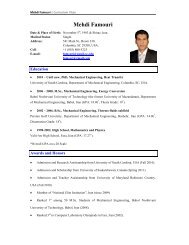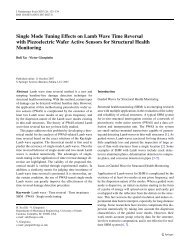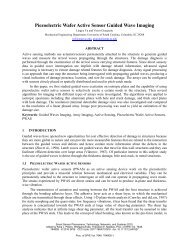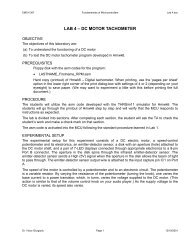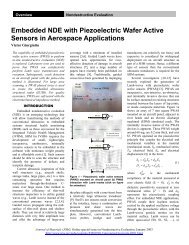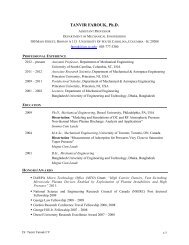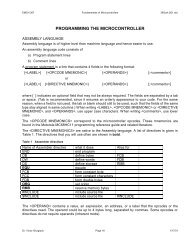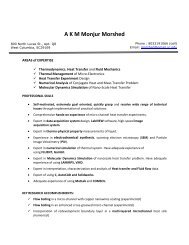1 COST BENEFIT ANALYSIS MODELS FOR EVALUATION OF ...
1 COST BENEFIT ANALYSIS MODELS FOR EVALUATION OF ...
1 COST BENEFIT ANALYSIS MODELS FOR EVALUATION OF ...
Create successful ePaper yourself
Turn your PDF publications into a flip-book with our unique Google optimized e-Paper software.
55 th Meeting of the Society for Machinery Failure Prevention Technology, April 2-6, 2001, Virginia Beach, VA<br />
<strong>COST</strong> <strong>BENEFIT</strong> <strong>ANALYSIS</strong> <strong>MODELS</strong> <strong>FOR</strong> <strong>EVALUATION</strong> <strong>OF</strong><br />
VMEP/HUMS PROJECT<br />
Victor Giurgiutiu, Georgiana Craciun, and Andrew Rekers<br />
University of South Carolina, Columbia, SC 29208<br />
Phone: 803-777-0660, FAX: 803-777-0106, E-mail: victorg@sc.edu,<br />
cracigeop4@spanky.badm.sc.edu, and rekers@engr.sc.edu<br />
Abstract: Models for cost benefit analysis (CBA) of vibration monitoring (VM) and<br />
Health Usage Monitoring Systems (HUMS) are discussed. A brief overview of CBA<br />
methods with examples of its application to large government funded projects is given.<br />
The objectives and projected benefits of the South Carolina Army National Guard<br />
(SCARNG) Army Aviation Support Facility (AASF) Vibration Management<br />
Enhancement Program (VMEP) are briefly reviewed. The cost components associated<br />
with this activity at the SCARNG/AASF operational unit are identified and discussed. A<br />
list of most costly maintenance parts and operations is given. Possible cost savings and<br />
cost differing components are analyzed from CBA perspective. As the implementation of<br />
the VMEP project has just started, the last part of the paper presents the projected CBA<br />
evaluation results.<br />
Key Words: Cost benefit analysis; Health usage monitoring system; Vibration<br />
management enhancement program; VMEP; HUMS; O&S; RT&B; SCARNG.<br />
INTRODUCTION<br />
Vibration Monitoring and HUMS activities are essential for reducing the operational and<br />
support (O&S) cost of Military and Civilian helicopters. In recent years, a significant<br />
number of VM/HUMS activities have proliferated in order to increase the safety, reduce<br />
maintenance cost, and eventually extend the life of existing helicopter fleets. In order for<br />
such VM/HUMS activities to be proven cost effective, a CBA must be preformed.<br />
The cost effectiveness of the VMEP/HUMS system usage on the SCARNG AH-64A<br />
Apache and UH-60 Blackhawk helicopters is determined using a modification of the<br />
RITA-HUMS CBA software. Data to be collected will include aircraft details and<br />
operating, maintenance, VMEP/HUMS equipment, and VMEP/HUMS installation cost.<br />
The output from the CBAM software includes benefit and cost tables showing impact of<br />
in-flight and mission abort for aircraft with and without VMEP/HUMS, maintenance and<br />
availability, and an estimation of aircraft maintenance cost. Based on this data,<br />
projections are made for future O&S cost. This data is then analyzed to provide a breakeven<br />
value for the VMEP/HUMS system on the SCARNG helicopter and determine the<br />
payback time horizon.<br />
1
REVIEW <strong>OF</strong> <strong>COST</strong>-<strong>BENEFIT</strong> <strong>ANALYSIS</strong> METHOD<br />
Currently, cost-benefit analysis (CBA) is largely used by government agencies. This is<br />
mainly due to the strong legislative actions taken by the Reagan and Clinton<br />
Administrations that issued Executive Orders endorsing the use of CBA. Executive Order<br />
12886 on Regulatory Planning and Review, signed by President Clinton on September<br />
30, 1993 requires agencies to perform cost-benefit analysis of proposed and final<br />
regulations. It revoked and replaced two executive orders issued under Reagan<br />
Administration: Executive Order 12911 requiring Regulatory Impact Assessment and<br />
Executive Order 12498 establishing the regulatory planning process. Moreover, the use<br />
of CBA by government agencies was enforced by Congress who enacted numerous<br />
statutes requiring agencies to perform CBA analyses.<br />
When used by governmental agencies, CBA attempts to measure, over a relevant time<br />
period, the change in societal well-being resulting from the implementation of a<br />
governmental project or the imposition of governmental regulations. It can provide<br />
information to decision makers on the merits of the current project or regulation as well<br />
as offer a framework for comparing a variety of project or regulatory alternatives.<br />
Agencies’ project or regulation evaluations are subject to the review of the Office of<br />
Management and Budget (OMB). In 1992 OMB issued the Circular No. A-94, which<br />
recommends the use of CBA in formal economic analyses of government programs or<br />
projects and provides general guidance for conducting CBA. Its goal is to “promote<br />
efficient resource allocation through well-informed decision-making by the Federal<br />
government”.<br />
CBA aims to present categories of costs and benefits in terms of dollars (so that the costbenefit<br />
comparison can be performed with a common unit of measurement); therefore,<br />
agencies have to define and monetize all categories of costs and benefits determined by<br />
the project implementation. Sometimes practical problems appear such as obtaining data,<br />
evaluating benefits and costs, etc. Monetization of some benefits categories may be<br />
controversial because indirect methods are often employed to estimate a value for goods<br />
that are not generally traded in the marketplace (e.g. estimate the monetary value of a<br />
reduction in risk of premature mortality). In this sense OMB stipulated, “Analyses should<br />
include comprehensive estimates of the expected benefits and costs to society based on<br />
established definitions and practices for program and policy evaluation. Social net<br />
benefits, and not the benefits and costs to the Federal Government, should be the basis for<br />
evaluating government programs or policies that have effects on private citizens or other<br />
levels of government. […] Both intangible and tangible benefits and costs should be<br />
recognized. […] Costs should reflect the opportunity cost of any resources used,<br />
measured by the return to those resources in their most productive application<br />
elsewhere”(OMB – A-94).<br />
Despite its recognized merit in providing important information and transparency in the<br />
governmental decision-making process, CBA was often criticized, especially by<br />
American academics who claim that CBA is an analytical technique that deals only with<br />
economic efficiency without considering who receives the benefits and who bears the<br />
costs. They also claim that CBA sometimes produces morally unjustified outcomes or it<br />
is not correctly used. Yet, it is important to highlight that CBA is a decision procedure or<br />
a method for achieving desirable results, and “some decision procedures are more<br />
2
accurate or less costly than others”. As long as it is used in the right way, meaning that<br />
under certain conditions agencies may need to modify the traditional approach of CBA,<br />
this decision procedure is justified if it is less costly than other procedures (e.g. risk-risk<br />
analysis, feasibility based assessment, etc.).<br />
In order to place CBA in context, a good example is the Environmental Protection<br />
Agency (EPA) monitoring of drinking water contamination with lead. By law, EPA has<br />
to regulate the water cleaning against lead contamination. Therefore, EPA used CBA to<br />
evaluate three rules it has previously issued as to lead contamination of water. On the cost<br />
side EPA took into consideration the cost of treating contaminated water that enters the<br />
distribution system; the cost of maintaining water quality (pH level, temperature, etc.);<br />
the cost of replacing lead pipes; the cost of warning the public of high lead levels and<br />
informing it of precautions; and the cost of monitoring water quality. These costs were<br />
put in balance with the health benefits accrued from avoiding hospitalization and medical<br />
treatment of contaminated persons and compensatory costs for lost productivity. After<br />
aggregating all these costs and benefits, EPA concluded that the total health benefits from<br />
corrosion control alone would be $63.8 billion over a twenty-year period, which vastly<br />
exceeded estimated costs of $4.2 billion (Adler and Posner, 1999). Thus, with a large<br />
amount of data the CBA analysis was very transparent and convincing so it justified the<br />
adopted rule. Yet, without justification, EPA did not include in its final CBA the benefits<br />
from reducing lead damage to plumbing components, even if these benefits had been<br />
evaluated.<br />
Some remarks have to be made. First, budgetary and time constraints may impede EPA,<br />
as well as other governmental agencies, from collecting all the necessary data. Second,<br />
when all data are available and easy to collect, agencies should try to monetize all costs<br />
and benefits and include them in their final CBA. This helps agencies to clearly present<br />
the effects of governmental projects and alert affected groups. Third, CBA is an<br />
important way for governmental agencies to defend their projects against critics coming<br />
from other agencies, as well as against legal and political challenges from affected<br />
groups. Finally, given its relative cheapness and transparency, CBA is considered the best<br />
procedure for agencies to use in evaluating their projects.<br />
The use of CBA is not limited to governmental agencies. The U.S. Army also employs<br />
this technique in estimating whether its projects achieve an improvement in the allocation<br />
of resources.<br />
CBA can provide valuable perspectives on the best ways to manage projects concerning<br />
the army infrastructure, labor force, capital stock etc. This approach is consistent with the<br />
Department of Defense and Army guidance and with the Army Regulation 11-18<br />
establishing responsibilities and policy for the Army’s Cost and Economic Analysis<br />
Program.<br />
For the design and manufacturing of the helicopter AH-64D Apache Longbow, Boeing<br />
Helicopter of Mesa, Arizona put up a multidisciplinary team focused on meeting the<br />
Army’s cost and performance requirements. This Integrated Product Development (IPD)<br />
team incorporated a manufacturing engineer, a design engineer, a tool engineer, and a<br />
stress engineer, and later on a material process engineer, purchasing personnel, and an<br />
industrial engineer who was called in to perform a CBA. During the project development,<br />
the team used the costing software Design for Manufacture and Assembly (DFMA) that<br />
3
provided “a means of before-and-after comparison – not only against the previous models<br />
[six Apache Prototypes] but for individual redesign ideas that are part of the iterative<br />
process”(Parker, 1997). Thus through continuous CBA the best alternative was chosen<br />
and the new Apache Longbow innovative production strategies not only proved better<br />
performance and quality, but also brought savings of $1.3 billion over the life of the<br />
program.<br />
MILITARY OPERATION AND SUPPORT <strong>COST</strong>S<br />
The Operation and Support (O&S) costs of US Army aviation are considerable.<br />
According to Defense Budget documents (DBD, 2000), the US Army spent $1,384M on<br />
aircraft in 1999, of which $930M were spent on modifications ($666M on AH-64A and<br />
D models), $36M on spare and repair parts, and $104M on support equipment and<br />
facilities. The Army flies around 180h/helicopter/year at a cost between $1,483/h for UH-<br />
60L Blackhawk to ~$5,000/h for AH-64D Longbow Apache. Of these flight hours,<br />
approximately 8% are used in maintenance test flights, including 5% for Rotor Track and<br />
Balance (RT&B), and 3% for others.<br />
Table I ARIP AH-64 cost reduction high demand items for 1995-1996. (ILTI, 1996)<br />
NSN NAME CNT QTY PRICE TOTAL <strong>COST</strong> %<strong>COST</strong> CUM%<br />
1 1615-01-332-0702 BLADE, MAIN 301 468 $99,797 $46,704,996 43.81% 43.81%<br />
2 1615-01-154-7076 STRAP ASSEMBLY 795 2,086 $6,670 $13,913,620 13.05% 56.86%<br />
3 1615-01-312-2387 BLADE, TAIL 221 386 $18,467 $7,128,262 6.69% 63.55%<br />
4 2840-01-345-2584 ROTOR COMPRES. 277 325 $18,933 $6,153,225 5.77% 69.32%<br />
5 3040-01-352-1531 CONNECTING LINK 534 1,171 $4,703 $5,507,213 5.17% 74.49%<br />
6 6115-01-224-9230 GENERATOR-ALT 274 329 $14,521 $4,777,409 4.48% 78.97%<br />
7 1650-01-263-7856 CYLINDER ASSEMBLY 232 325 $9,355 $3,040,375 2.85% 81.82%<br />
8 2835-01-164-5786 CLUTCH, ASSEMBLY 211 237 $12,467 $2,954,679 2.77% 84.59%<br />
9 1615-01-235-5345 HOUSING ASSEMBLY 202 366 $6,674 $2,442,684 2.29% 86.88%<br />
10 3010-01-364-2470 CLUTCH ASSEMBLY 247 496 $4,033 $2,000,368 1.88% 88.76%<br />
11 4320-01-158-0893 AXIAL PUMP 227 313 $5,693 $1,781,909 1.67% 90.43%<br />
OTHERS $10,199,239 9.57% 100.00%<br />
Total cost $106,603,978<br />
A statistical study of AH-64 Apache premature failures performed by Innovative<br />
Logistics Techniques, Inc. (ILTI, 1996) indicated that 81% of parts removal occurred on<br />
some 40 items. Industry and government cooperation in addressing O&S costs<br />
improvements with emphasis on readiness drivers, high removal rates, and laborintensive<br />
items, is required. Analysis of 2-year data from the Apache Readiness<br />
Improvement Program (ARIP) tracking AH-64 high demand items revealed that out of<br />
the ~$106M costs, 90% were expended on 11 high cost/demand items (Table I).<br />
4
CBA <strong>OF</strong> HEALTH AND USAGE MONITORING SYSTEMS (HUMS)<br />
The use of Health and Usage Monitoring Systems (HUMS) can significantly reduce the<br />
cost of helicopter O&S activities. Detection of incipient failure in critical components can<br />
prevent costly aircraft accidents. Whereas life extension and condition based maintenance<br />
is expected to significantly reduce the unwarranted replacement of ‘healthy” parts. A<br />
major effect will come from the reduction of general vibration levels through improved<br />
Rotor Track and Balance (RT&B) procedures. Data recorded during the 1994-1996<br />
period at the South Carolina Army National Guard – Army Aviation Support Facility<br />
(SCARNG-AASF) indicates that vibration reduction obtained through the<br />
implementation of RT&B function of the Aviation Vibrations Analyzer (AVA) could<br />
have saved $2M on TADS/PNVS visionics systems alone. At present, SCARNG-AASF<br />
is replacing AVA with the more advanced Vibrations Management Enhancement<br />
Program (VMEP) technology (Giurgiutiu et al., 2000). Preliminary tests with the VMEP<br />
neural networks (NN) algorithms for improved RT&B have already shown 40%<br />
reduction in the number of maintenance test flights, and lower vibration levels when<br />
compared with existing AVA algorithms. As predicted, considerable O&S cost reduction<br />
is expected.<br />
Figure 1 Overall architecture of the RITA HUMS Cost Benefit Analysis Model (RITA, 1998).<br />
A major obstacle that prevents the wide spread dissemination of HUMS systems is the<br />
lack of irrefutable hard evidence that their implementation will actually reduce the<br />
helicopter O&S life-cycle costs and actually save money. Crews (1991) indicated, “many<br />
in the helicopter community have long felt that there is a direct relationship between<br />
helicopter reliability and maintainability and the level of vibrations allowed on the<br />
helicopters. This is a difficult thesis to prove for a number of reasons and skeptics have<br />
argued for hard proof that this is indeed true before they would allow significant dollars<br />
to be spent on efforts to reduce helicopter vibration.” The transition from scheduled<br />
overhauls (where early removal of ‘perfectly good’ parts is practiced) to condition-based<br />
maintenance with ‘just-in-time’ replacements is expected to save considerable O&S<br />
costs. To verify this, good statistical models, carefully conducted experiments, and<br />
5
statistically significant data collected on a sufficiently large sample of service helicopters<br />
are needed. Cost-benefit analysis (Nas, 1996) has been used in the past for effectiveness<br />
evaluation of space technology (Hein, 1976) and national aviation system (Noah, 1977).<br />
Booz-Allen & Hamilton, Inc. developed during 1995-1999 the RITA HUMS Cost and<br />
Benefits Analytical Model (CBAM) software (RITA, 1999) under joint funding from the<br />
US rotorcraft industry and government (Figure 1). In 1999, USC obtained access to an<br />
evaluation copy of the CBAM software for use on the VMEP project. Our analysis is<br />
planned as follows:<br />
Thrust 1 Cost-benefits analysis model for O&S costs at SCARNG-AASF operational<br />
unit level. A model to track O&S costs at operational-unit level is being established for<br />
the organizational structure of SCARNG-AASF and its operational costs environment.<br />
The model will use the RITA-HUMS CBAM software framework customized to the<br />
SCARNG-AASF organizational structure. The model will track the costs associated with<br />
the acquisition, installation, and support of the VMEP-HUMS, and associated impact on<br />
the unit-level operations. The model will identify the benefits resulting from VMEP-<br />
HUMS usage in terms of increased availability, reduced mission aborts and flight<br />
mishaps, and reduction of maintenance flights for validation of replaced equipment and<br />
RT&B vibration reduction. The result of the cost-benefit analysis will be presented in<br />
terms of return on investment (ROI), present value analysis, flight hour cost reports, and<br />
a graphic representation of payback point.<br />
Thrust 2 Conduct statistically designed experiments at SCARNG-AASF in<br />
connection with the VMEP program. Statistical groups of ‘control’ and ‘exposure’<br />
helicopters will be established from the SCARNG-AASF AH-64 and UH-60 fleet. The<br />
exposure helicopters will be fitted with VMEP-HUMS equipment and will follow the<br />
VMEP-HUMS O&S procedures, while the control helicopters will be equipped, operated,<br />
and maintained in strict accordance with established Army procedures. Full data<br />
monitoring and recording will be performed on both control and exposure helicopters.<br />
The O&S data tracked during this experiment will be collected through Unit Level<br />
Logistics Systems-Aircraft (ULLS-A) and electronically transferred to the USC data<br />
repository for processing, analysis, and interpretation.<br />
Thrust 3 Process statistical data with data-mining algorithms to establish<br />
correlations and O&S costs trends. Data mining is an artificial-intelligence<br />
methodology based on data analysis tools that discover data patterns and relationships<br />
suitable for prediction and extrapolation. Using data collected during the initial Thrust 2<br />
experiments, data-mining algorithms will establish O&S cost reduction predictions that<br />
will be tested on additional data collected during follow-up Thrust 2 experiments. This<br />
iterative approach will assure model robustness and stability. Activity based costing<br />
(McDonald et al., 1998) will be used to properly track some non-technical related costs.<br />
Thrust 4 Verify the level of O&S cost reduction achieved through HUMS vibration<br />
management and develop cost-reduction predictions. A number of overall cost and<br />
reliability outcomes will result from the collected data, such as: (a) time between failure<br />
(TBF) and time between maintenance action (TBMA) on critical and/or high cost<br />
components; (b) inventory costs; (c) flight time allocated to maintenance actions; (d)<br />
downtime. Besides these general trends, systematic valuation of the dollar costs and<br />
benefits associated with the VMEP program implementation will be applied. These data<br />
6
will be processed with the CBAM software to reveal ROI, net present value (NPV),<br />
payback period, and future O&S cost savings.<br />
EXPECTED <strong>BENEFIT</strong>S <strong>OF</strong> USING HEALTH AND USAGE MONITORING<br />
SYSTEMS<br />
This study will demonstrate that the use of HUMS systems may produce sizable O&S<br />
cost savings and improve affordability of Army helicopters. The benefits of the HUMS<br />
system, experienced initially by the unit-level maintenance managers, will eventually<br />
propagate through the Army Logistics Network. Process improvements at unit level,<br />
higher availability, reduced direct operating costs, and avoidance of expensive<br />
maintenance flights are the principal significant benefits expected from this study.<br />
RULES <strong>OF</strong> A GOOD CBA MODEL<br />
There are rules that must be followed in order to have a good CBA model. First the<br />
estimates of expected cost and benefits must be provided and clearly defined. Both the<br />
intangible and tangible benefits and costs should be included in the analysis. Cost should<br />
be defined in terms of opportunity cost and incremental costs. All cost should be inflated<br />
or deflated over the life of the analysis. The model needs to provide for the review and<br />
modification of all algorithms used in the model. The CBA model needs to calculate<br />
recurring and nonrecurring cost as well as be easy to use with good documentation of<br />
equations and help menus. These rules will provide for an efficient and well-documented<br />
CBA.<br />
RITA-HUMS CBAM S<strong>OF</strong>TWARE OVERVIEW<br />
There are two main components of the RITA HUMS CBAM Model. The first is the<br />
operator’s module. The purpose of this module is to identify HUMS functions that<br />
provide the most value added and the maximum benefit to the operator. This includes<br />
reduction in cost per hour, the payback period, and the total dollar savings over the<br />
rotorcrafts’ expected life. The second is the manufacture’s module. This module gives the<br />
ability to create databases from scratch, generic databases, or an existing aircraft<br />
database. The analytical side of manufacturer’s module includes the development of these<br />
aircraft databases to support the evaluation of prospective HUMS implementations. There<br />
are two distinct components in this module, the aircraft database and the analysis.<br />
The inputs into the CBAM software include the type of analysis, aircraft details, and a<br />
definition of anticipated aircraft usage. The type of analysis includes whether the aircraft<br />
is military or commercial. The AH-64 and the UH-60 helicopters fall under the military<br />
analysis. The market value, insurance, and operating cost are entered under the input of<br />
aircraft details. The definition of the anticipated aircraft usage is inputted at this point in<br />
the software.<br />
The outputs of the software include cost, benefit, and other tables as well as a payback<br />
graph. The cost tables include the HUMS equipment, installation, and operating cost. The<br />
benefit tables include an estimation of aircraft maintenance cost, impact of in-flight and<br />
mission abort, maintenance and availability, and mishaps for the aircraft. The individual<br />
HUMS functions, mission profiles, and support equipment are listed in other tables in the<br />
7
output. The analysis results of the RITA HUMS CBAM software include the direct<br />
investment, benefit elements, return on investment, unit cost, present value analysis,<br />
flight hour cost, and a graphical representation of the payback point.<br />
PROS AND CONS <strong>OF</strong> THE RITA-HUMS CBAM S<strong>OF</strong>TWARE<br />
The software is user friendly when it comes to inputting the data, but several problems<br />
still exist. There is a problem with acronyms within the software. There is no explanation<br />
for the meaning of many of the acronyms involved in the software. The wizard will ask<br />
for an entry, but it will not give the definition of the acronym. There is also some<br />
confusion on why some of the data is needed in the final CBA. Because the algorithms<br />
are not clearly defined or stated, it is difficult to determine which data entries effect what<br />
in the final CBA.<br />
One problem with the CBAM software is that it does not have the customization potential<br />
that other models have. If a cost concern is thought to affect the final outcome of the<br />
model, it is impossible to add this concern to the model. It is also difficult to see how<br />
certain inputs affect the cost benefit of the HUMS system. Certain inputs were changed<br />
dramatically with unpredictable results in the final analysis.<br />
The help menus are useful in navigating through the input wizard, but offer very little<br />
help in the direction taken in the output. There are many pros for this model, but because<br />
it does not fit exactly the situation at SCARNG-AASF, it is difficult to get an accurate<br />
depiction of the cost savings by using this software.<br />
CBA <strong>FOR</strong> EVALUATING VMEP<br />
At the University of South Carolina, a research CBA module, using Excel software, has<br />
been developed. During our research, it was found that CBA is a useful way of<br />
organizing a comparison of different alternatives of a project. It can help the decision<br />
maker better understand the implications of a decision. Yet, not all impacts of a decision<br />
can be quantified or expressed in dollar terms. (e.g., intangible benefits such as aircraft<br />
availability, safety, and moral). Therefore, care should be taken to ensure that quantitative<br />
factors do not dominate important qualitative factors in decision-making.<br />
In performing CBA for evaluating VMEP activities, we start from the baseline process<br />
and compare it to the VMEP alternative. The cost of the current process at SCARNG-<br />
AASF provides the baseline for the CBA. In our case, benefits take the form of savings<br />
and non-tangible benefits. Therefore, we first analyze the savings of the VMEP<br />
alternative by comparing the costs in the two cases. Then we discuss the non-tangible<br />
benefits of the VMEP alternative and their implications. For comparing the VMEP<br />
alternative with the baseline, we define common cost elements (Table II).<br />
Table II<br />
Cost Elements (costs per aircraft)<br />
First Year Second Year Third Year Fourth Year Fifth Year Sixth Year<br />
Cost Variables - (per a/c) VMEP Baseline VMEP Baseline VMEP Baseline VMEP Baseline VMEP Baseline VMEP Baseline<br />
RT&B OCCURRENCE RATE - (a/c per year) 12 24 12 24 12 24 10 24 8 24 8 24<br />
MAINTENANCE FLIGHT HOURS - (per a/c RT&B) 6 6 6 6 3 6 3 6 3 6 3 6<br />
VMEP INVESTMENT - ($10K+12K/ a/c) $22K - - - - - - - - - - -<br />
FLIGHT HOUR <strong>COST</strong> - (not including fuel) $1.5K $1.5K $1.5K $1.5K $1.5K $1.5K $1.5K $1.5K $1.5K $1.5K $1.5K $1.5K<br />
MAINTENANCE <strong>OF</strong> HUMS ON-BOARD EQUIPMENT $2K - $2K - $2K - $2K - $2K - $2K -<br />
PARTS - (high cost items) $300K $300K $300K $300K $290K $300K $275K $300K $250K $300K $225K $300K<br />
MAINTENANCE FLIGHT HOURS <strong>COST</strong> - (per a/c RT&B) $9K $9K $9K $9K $5K $9K $5K $9K $5K $9K $5K $9K<br />
OPERATIONAL FLIGHT HOURS <strong>COST</strong> $229K $208K $229K $208K $229K $208K $229K $208K $229K $208K $229K $208K<br />
8
Disclaimer: To avoid un-appropriate disclosure of information, the actual dollar values have been modified, while<br />
maintaining a realistic order of magnitude.<br />
Table III<br />
Operational<br />
Flight Hours<br />
Costs<br />
VMEP Costs for SCARNG-AASF Fleet<br />
Maintenance<br />
Flight Hours<br />
Costs<br />
VMEP<br />
Discounted<br />
Cost Flows<br />
VMEP<br />
VMEP Annual Discount<br />
Year Investment<br />
Parts Maintenance costs factor<br />
I OC MC P M AC DF AC/DF<br />
1 $396K $4.1M $162K $5.4M $36K $10.1M 1.0000 $10.1M<br />
2 - $4.1M $162K $5.4M $36K $9.7M 1.0300 $9.4M<br />
3 - $4.1M $81K $5.2M $36K $9.5M 1.0609 $8.9M<br />
4 - $4.1M $81K $5.0M $36K $9.2M 1.0927 $8.4M<br />
5 - $4.1M $81K $4.5M $36K $8.7M 1.1255 $7.8M<br />
6 - $4.1M $81K $4.1M $36K $8.3M 1.1593 $7.2M<br />
Total $396K $24.8M $648K $29.5M $216K $55.5M $51.8M<br />
Table IV<br />
Operational<br />
Flight Hours<br />
Costs<br />
Baseline Costs for SCARNG-AASF Fleet<br />
Maintenance<br />
Flight Hours<br />
Costs<br />
Baseline<br />
Discounted<br />
Cost Flows<br />
VMEP<br />
VMEP Annual Discount<br />
Year Investment<br />
Parts Maintenance costs factor<br />
I OC MC P M AC DF AC/DF<br />
1 - $3.8M $162K $5.4M - $9.3M 1.0000 $9.3M<br />
2 - $3.8M $162K $5.4M - $9.3M 1.0300 $9.0M<br />
3 - $3.8M $162K $5.4M - $9.3M 1.0609 $8.8M<br />
4 - $3.8M $162K $5.4M - $9.3M 1.0927 $8.5M<br />
5 - $3.8M $162K $5.4M - $9.3M 1.1255 $8.3M<br />
6 - $3.8M $162K $5.4M - $9.3M 1.1593 $8.0M<br />
Total - $22.5M $972K $32.4M - $55.9M $52.0M<br />
Yet, we cannot properly compare the two competing alternatives if we do not convert<br />
them to a common unit of measurement. Therefore, we discount future dollar values to a<br />
present value (also referred to as the discounted value). Present values are cash flows that<br />
occur now or in the immediate future<br />
Project costs<br />
$10.5M<br />
$9.5M<br />
$8.5M<br />
$7.5M<br />
$6.5M<br />
0 1 2 3 4 5 6 7<br />
Years<br />
VMEP Discounted Cost<br />
Flow s<br />
Baseline Discounted<br />
Cost Flow s<br />
Figure 2 Annual discounted costs for VMEP and<br />
baseline alternatives<br />
9<br />
and may include start-up expenses<br />
(VMEP investment) as well as any<br />
other expenses or incomes that occur<br />
at or close to the beginning of the<br />
project. Future values are the cash<br />
flows that occur sometime in the<br />
future. By converting all the future<br />
values to present values, we perform<br />
a present value analysis that will tell<br />
us what our project is worth in<br />
equivalent dollars right now. The<br />
formula we use is: PV=FV/(1+I) (n-1) ,<br />
where PV=Present Value,<br />
FV=Future Value, I=Interest Rate,<br />
and n=number of years. Tables III<br />
and IV show the annual discounted<br />
costs for both alternatives. For exemplification, we have chosen a six-year period of<br />
analysis. Cost data have been collected for estimating the costs and savings of each of the<br />
two project alternatives (baseline and VMEP) for each year of analysis. The annual costs<br />
are discounted to reflect the dollar depreciation, based on an interest rate of 3%. This<br />
interest rate was chosen based on public information about the present trends in the US<br />
economy. Figure 2 shows that in the first three years the VMEP project is more costly<br />
than the baseline, due to an initial investment of $22k/aircraft and additional VMEP
maintenance costs. However, after three and a half years the VMEP project attains the<br />
break-even point. From that point on the VMEP project costs fall sharply below the<br />
baseline costs and, consequently, savings are increasing. Furthermore, at the end of the 6-<br />
year period of analysis, the cumulative discounted cost flow for the VMEP alternative<br />
falls bellow the same cost for the baseline. Thus, a positive present value of $149,000<br />
shows that the VMEP alternative is favorable.<br />
The benefit variables in our analysis cannot be linked directly to a monetary value like<br />
the cost variables. They do ultimately affect the overall monetary value of the VMEP<br />
project, but cannot be linked to a dollar figure in the same way the cost variables are<br />
linked. Instead, the availability and safety variables are set up using a percentile<br />
comparison. A numeric tally is used to compare the premature parts failure, mission<br />
aborts, and the unscheduled maintenance occurrence. Moral could not be quantified in a<br />
normal scale. It is quantified by an increase in the specified year. The benefits of the<br />
VMEP project need to be looked at as non-tangible benefits and not necessarily a<br />
monetary gain. Therefore, CBA is important when VMEP and HUMS activities are<br />
essential for reducing O&S cost of Military and Civilian helicopters.<br />
REFERENCES<br />
Adler, Matthew; Posner, Eric. (1999) “Rethinking cost-benefit analysis”, University of Chicago Law School,<br />
John M. Olin Law & Economics Working Paper No. 72, May27, 1999<br />
Army Regulation 11-18. (1995) The Cost and Economic Analysis Program. 31 Jan. 1995<br />
Crews, S. T. (1991) “Helicopter Vibration and its Effect on Operating Costs and Maintenance Requirements”,<br />
AVCOM, Huntsville, AL, 1991.<br />
Dasgupta, Ajit K.; Pearce, D.W. (1972) Cost-benefit analysis: theory and practice. London, MacMillan, 1972,<br />
pp 12-13.<br />
DBD (2000) “FY 2000 Defense Budget Documents”, Office of the Assistant Secretary of the Army for<br />
Financial Management and Comptroller, http://www.fas.org/man/docs/fy00/topics.htm<br />
Exec. Order No. 12886, 3 C.F.R. 638, 639 (1993).<br />
Giurgiutiu, V.; Grant, L. Grabill, P.; Wroblewski, D. (2000) “Helicopter Health Monitoring and Failure<br />
Prevention through Vibration Management Enhancement Program”, Proceedings of the 54th Meeting of<br />
the Society for Machinery Failure Prevention Technology, May 1-4, 2000, Virginia Beach, VA pp. 593-<br />
602.<br />
Hein, G. F. (1976) “Cost Benefit Analysis of Space Technology”, NASA, 1976<br />
ILTI (1996) “Premature Failures”, PAT Meeting, 7-9 May 1996, Innovative Logistics Technologies, Inc.<br />
McDonald, D.; Cushman, B.; McNabb, S. (1998) “Activity Based Costing”, Booz-Allen & Hamilton, Inc.,<br />
DAL Conference, September 30, 1998, Seattle, WA.<br />
Milford, S.; McNabb, S.; Sanders, T.; Phillips, K. (1998) “DAL-P Cost/Benefit Analysis”, Booz-Allen &<br />
Hamilton, Inc., DAL Conference, September 30, 1998, Seattle, WA.<br />
Nas, Tevfik (1996)“Cost Benefit Analysis: Theory and Practice”, Sage Pub., 1996.<br />
Noah, J. W. (1977) “Cost Benefit Analysis of the National Aviation System”, FAA, 1977.<br />
Office of Management and Budget. (1992) Circular A-94 Revised, Oct. 29, 1992<br />
Parker, M. (1997) Mission Possible. Improving design and reducing costs at Boeing Helicopter. IIE Solutions,<br />
vol. 29, Dec. 1997, pp. 20-24<br />
Pearce, D.W.; Nash, C.A. (1981) The social appraisal of projects: a text on cost-benefit analysis. New York:<br />
John Wiley & Sons, 1981, pp 3-4.<br />
Porter, Theodore M. (1995) Trust in numbers: the pursuit of objectivity in science and public life. Princeton,<br />
N.J.: Princeton University Press, 1995, pp 148-89.<br />
RITA (1999) “RITA-HUMS Cost Benefits Analytical Model (CBAM) software”, Rotorcraft Industry<br />
Technology Association, Inc., 1999.<br />
Unfunded Mandates Reform Act (P.L. 104-4) (1995)<br />
10



